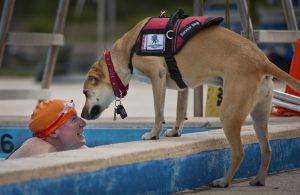The Truth About Service Dogs
Author: Amy Adams, Clinical Pharmacist 
People bringing emotional support peacocks, ducks, kangaroos and other exotic animals on airplanes often lead to viral news headlines. While it’s fun to read about these wild stories, it’s important to remember the difference between emotional support animals and service dogs. Both are important lifelines for many people but there are different legal regulations. The International Association of Canine Professionals (IACP) explains the difference between service dogs and emotional support animals.
Service Dog Definition
The Americans with Disabilities Act (ADA) defines service animals as a dog that receives special training to support an individual with a disability. Service dogs are trained to help as diabetic alert dogs, severe allergy alert dogs, visual assistance dogs, psychiatric service dogs, seizure assistance dogs and more. Sometimes service dogs are trained in multiple areas to offer support for more than one condition and meet their owner’s needs.
Service Dogs vs. Working and Therapy Dogs
People often confuse service dogs with working dogs or therapy dogs. Working dogs perform tasks to assist with human jobs. Popular examples of working dogs include bed bug sniffers, search and rescue dogs and police dogs in the K-9 unit. Therapy dogs typically volunteer with their owners in schools, hospitals and nursing homes to provide comfort and companionship. Therapy dogs, also called emotional support animals, are not service animals and do not have the same rights under the ADA. The American Kennel Club provides more information about different areas of the canine workforce.
There are many different kinds of service dogs. Service animals are specially trained to provide assistance and make life easier for their owners. Common types of service animals include severe allergy alert dogs, brace/mobility support dogs, diabetic alert dogs, seizure response dogs and medical assistance dogs.
Severe Allergy Alert Dogs
Severe allergy alert dogs (AAD) help people with life-threatening allergies avoid their allergens. They’re often used for people who are seriously allergic to nuts or shellfish.
Brace/Mobility Support Dogs
Brace/mobility support dogs (BMSD) are great for people who have trouble with everyday movements. These service animals provide counterbalance to their handler and can open or close doors and accomplish other daily tasks.
Diabetic Alert Dogs
Diabetic alert dogs (DAD) can detect when their owner’s blood sugar levels reach dangerous levels, whether too high or too low. In emergencies, these dogs can use special phones to contact 911 and get help.
Seizure Response Dogs
Seizure response dogs perform a variety of tasks, depending on their training. These dogs may be trained to brace their owner’s fall during a seizure, contact 911, retrieve medication or alert a person nearby of a seizure event.
Similar to seizure response dogs, seizure alert dogs are trained to predict oncoming seizures. While there are families who insist their dog alerts them about oncoming seizures, some neurology experts are skeptical.
Medical Assistance Dogs
Medical assistance dogs are service animals who receive special training, depending on their owner’s unique condition. If there isn’t a specific category for a service dog’s skills, they will be classified as a medical assistance dog.
Additional Benefits of Service Dogs
In addition to providing important support for their owners, service dogs have other health benefits. Owning a dog can motivate people to get more exercise with their furry friend. It can also help people make friends. According to a study from Harvard Health, pets can help their owners connect with human friendships and social support. Owning a dog may help lower your blood pressure and improve heart health.
Service Dog Etiquette
Service dogs are often distinguished by a vest or special harness. If you see a service dog, do not pet or distract the dog without first asking its owner. Even if the dog appears to be sleeping, that doesn’t mean it’s off the clock. Service dogs are still in-tune with their owner’s needs when their eyes are closed. Don’t offer food or treats to a service animal because this can be a major distraction for them. Keep your own dog away from the service animal to help the service dog stay focused.
When it comes to choosing your service dog, there’s a lot to consider. Anything Pawsable offers their tips on how to select the best service dog to meet your needs. Service dogs make life easier for their owners. Hy-Vee Pharmacy Solutions (HPS) shares that goal of making life easier, happier and healthier for our patients. HPS takes a whole-health approach to helping our patients manage chronic, complex conditions. Visit our website to learn more about the conditions we treat and the services we offer.
